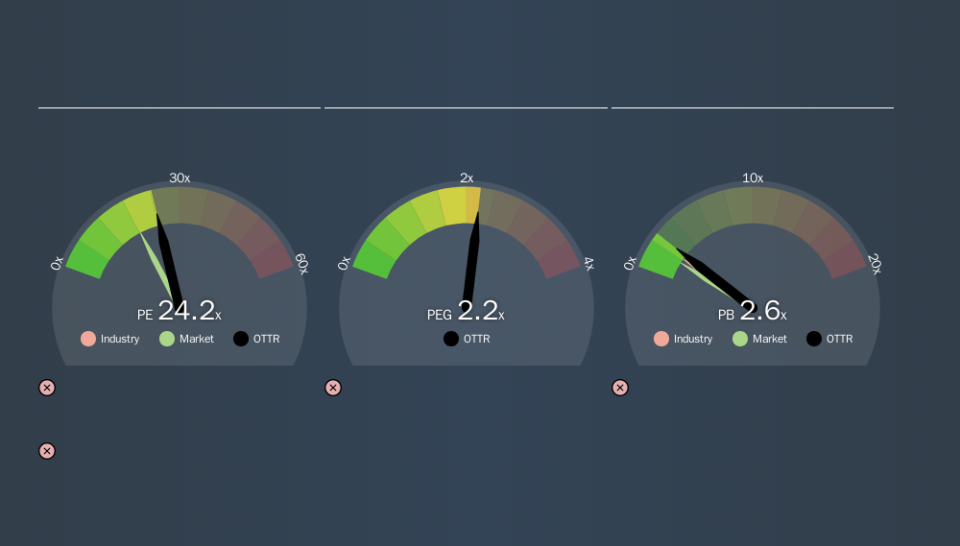Is Otter Tail Corporation's (NASDAQ:OTTR) High P/E Ratio A Problem For Investors?

This article is for investors who would like to improve their understanding of price to earnings ratios (P/E ratios). We'll show how you can use Otter Tail Corporation's (NASDAQ:OTTR) P/E ratio to inform your assessment of the investment opportunity. Looking at earnings over the last twelve months, Otter Tail has a P/E ratio of 24.23. That is equivalent to an earnings yield of about 4.1%.
Check out our latest analysis for Otter Tail
How Do You Calculate A P/E Ratio?
The formula for P/E is:
Price to Earnings Ratio = Price per Share ÷ Earnings per Share (EPS)
Or for Otter Tail:
P/E of 24.23 = $49.25 ÷ $2.03 (Based on the year to September 2019.)
Is A High Price-to-Earnings Ratio Good?
A higher P/E ratio means that buyers have to pay a higher price for each $1 the company has earned over the last year. That isn't necessarily good or bad, but a high P/E implies relatively high expectations of what a company can achieve in the future.
How Does Otter Tail's P/E Ratio Compare To Its Peers?
The P/E ratio essentially measures market expectations of a company. As you can see below Otter Tail has a P/E ratio that is fairly close for the average for the electric utilities industry, which is 23.6.
That indicates that the market expects Otter Tail will perform roughly in line with other companies in its industry. The company could surprise by performing better than average, in the future. Checking factors such as director buying and selling. could help you form your own view on if that will happen.
How Growth Rates Impact P/E Ratios
Generally speaking the rate of earnings growth has a profound impact on a company's P/E multiple. When earnings grow, the 'E' increases, over time. Therefore, even if you pay a high multiple of earnings now, that multiple will become lower in the future. A lower P/E should indicate the stock is cheap relative to others -- and that may attract buyers.
Otter Tail shrunk earnings per share by 7.1% last year. But it has grown its earnings per share by 6.5% per year over the last five years.
Don't Forget: The P/E Does Not Account For Debt or Bank Deposits
The 'Price' in P/E reflects the market capitalization of the company. That means it doesn't take debt or cash into account. Theoretically, a business can improve its earnings (and produce a lower P/E in the future) by investing in growth. That means taking on debt (or spending its cash).
Spending on growth might be good or bad a few years later, but the point is that the P/E ratio does not account for the option (or lack thereof).
How Does Otter Tail's Debt Impact Its P/E Ratio?
Otter Tail has net debt equal to 36% of its market cap. You'd want to be aware of this fact, but it doesn't bother us.
The Verdict On Otter Tail's P/E Ratio
Otter Tail trades on a P/E ratio of 24.2, which is above its market average of 18.2. With modest debt but no EPS growth in the last year, it's fair to say the P/E implies some optimism about future earnings, from the market.
Investors should be looking to buy stocks that the market is wrong about. If the reality for a company is better than it expects, you can make money by buying and holding for the long term. So this free report on the analyst consensus forecasts could help you make a master move on this stock.
Of course you might be able to find a better stock than Otter Tail. So you may wish to see this free collection of other companies that have grown earnings strongly.
We aim to bring you long-term focused research analysis driven by fundamental data. Note that our analysis may not factor in the latest price-sensitive company announcements or qualitative material.
If you spot an error that warrants correction, please contact the editor at editorial-team@simplywallst.com. This article by Simply Wall St is general in nature. It does not constitute a recommendation to buy or sell any stock, and does not take account of your objectives, or your financial situation. Simply Wall St has no position in the stocks mentioned. Thank you for reading.

 Yahoo Finance
Yahoo Finance 
